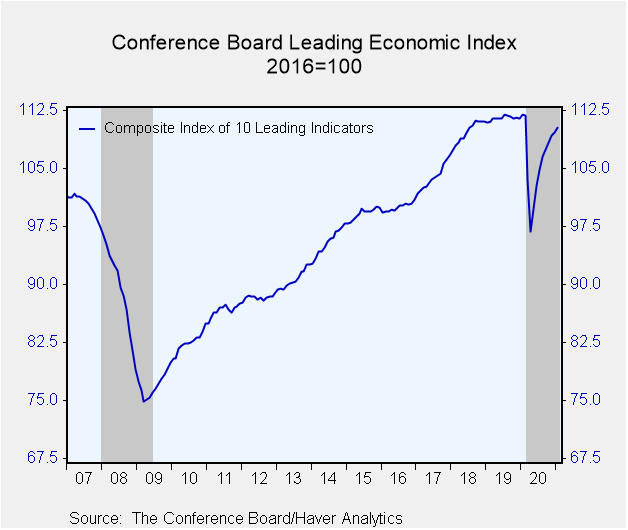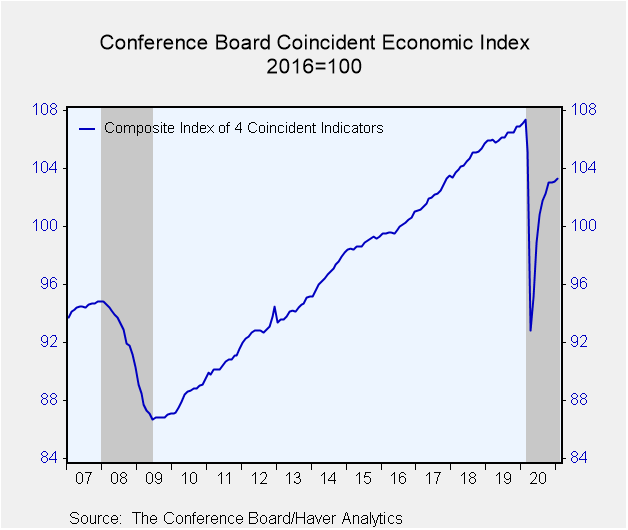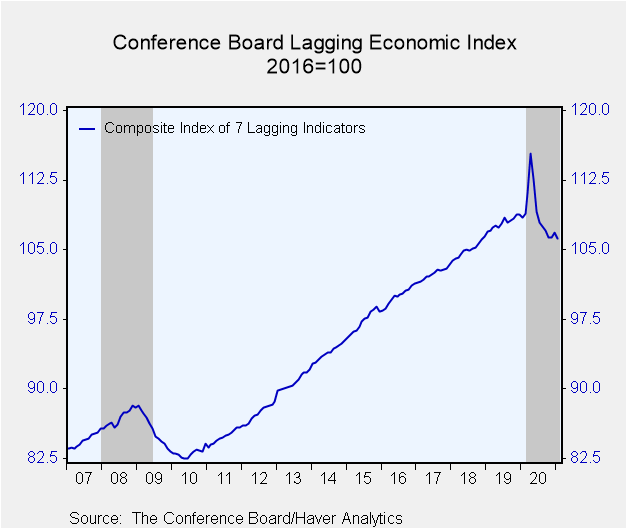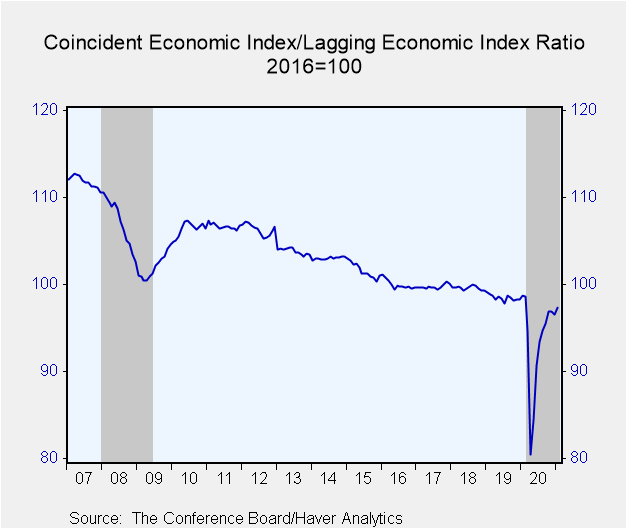 Global| Feb 22 2021
Global| Feb 22 2021U.S. Leading Indicators Continue Their Rise in January
by:Tom Moeller
|in:Economy in Brief
Summary
• Leading index gains decelerate. • Breadth of component growth moderates. • Coincident indicators rise is negligibly. The Conference Board's Composite Index of Leading Economic Indicators increased 0.5% (-1.5% y/y) during January [...]
• Leading index gains decelerate.
• Breadth of component growth moderates.
• Coincident indicators rise is negligibly.
The Conference Board's Composite Index of Leading Economic Indicators increased 0.5% (-1.5% y/y) during January after rising 0.4% in December, revised from 0.3%. The Action Economics survey anticipated a 0.3% rise. The Leading Index is comprised of 10 components which tend to precede changes in overall economic activity.
Seven of the ten components contributed positively to the index change last month, down modestly from both October and November. Building permits strengthened for the third straight month. The ISM new orders index continued its recent rise. Stock prices increased and the slope of the yield curve series rose sharply. The average workweek lengthened following two months of stability. Consumer expectations for business/economic conditions eased for the third straight month.
The Index of Coincident Economic Indicators increased 0.2% (-3.5% y/y) during January following a 0.1% December uptick, revised from 0.3%. Each of the four component series contributed positively to the index, including payroll employment, industrial production, personal income less transfers and manufacturing & trade sales.
The Index of Lagging Indicators fell 0.6% (-2.1% y/y) following a 0.5% December rise, revised from 0.1%. Fewer C&I loans and a longer average duration of unemployment contributed negatively to the index change.
The Conference Board figures are available in Haver's BCI database; the components are available there, and most are also in USECON. The expectations are in the AS1REPNA database. Visit the Conference Board's site for coverage of leading indicator series from around the world.
| Business Cycle Indicators (%) | Jan | Dec | Nov | Jan Y/Y | 2020 | 2019 | 2018 |
|---|---|---|---|---|---|---|---|
| Leading | 0.5 | 0.4 | 0.9 | -1.5 | -4.9 | 1.6 | 5.6 |
| Coincident | 0.2 | 0.1 | 0.0 | -3.5 | -4.3 | 1.6 | 2.4 |
| Lagging | -0.6 | 0.5 | 0.0 | -2.1 | 1.0 | 2.8 | 2.5 |
Tom Moeller
AuthorMore in Author Profile »Prior to joining Haver Analytics in 2000, Mr. Moeller worked as the Economist at Chancellor Capital Management from 1985 to 1999. There, he developed comprehensive economic forecasts and interpreted economic data for equity and fixed income portfolio managers. Also at Chancellor, Mr. Moeller worked as an equity analyst and was responsible for researching and rating companies in the economically sensitive automobile and housing industries for investment in Chancellor’s equity portfolio. Prior to joining Chancellor, Mr. Moeller was an Economist at Citibank from 1979 to 1984. He also analyzed pricing behavior in the metals industry for the Council on Wage and Price Stability in Washington, D.C. In 1999, Mr. Moeller received the award for most accurate forecast from the Forecasters' Club of New York. From 1990 to 1992 he was President of the New York Association for Business Economists. Mr. Moeller earned an M.B.A. in Finance from Fordham University, where he graduated in 1987. He holds a Bachelor of Arts in Economics from George Washington University.










